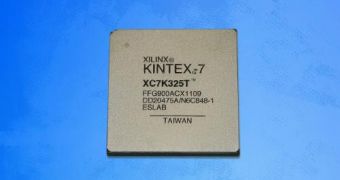Xilinx has just announced that it has started to supply its customers with 7-series field programmable gate arrays (FPGAs) made using TSMC's 28nm fabrication process. This makes Xilinx the first FPGA manufacturer to release chips based on the new 28nm node.
For starters, the company will only offer a 28nm version of a mid-range Kintex-7 FPGA, but this will be soon followed by other solutions, such as the company's Artix-7 and Viretex-7 chips.
Although they are targeting different market segments, all Xilinx FPGA chips are based on the same architecture, so its customers can start to develop their solution right now using the Kintex-7 and transfer them later on the 28nm Artix-7 and Virtex-7 FPGAs once they become available.
According to Xilinx, the Kintex-7 FPGAs delivers twice the performance of the company's previous mid-range solutions while consuming 50% less power, and can have between 30,400 and 477,760 logic cells, up to 74,650 slices, 34.4Mb of block RAM and a second-generation PCI Express x8 interface.
“The optimal price performance available in the Kintex-7 family makes it an ideal fit for our next generation visualization products,” said Eric Wogsberg, CEO of Jupiter Systems.
“The new 7 series unified architecture also allows us to start developing products today that use Kintex-7 and later upgrade to more advanced products that will use the Virtex-7 FPGA family.
“This lowers our development cost and allows us to build scalable solutions,” said Mr. Wogsberg.
The first samples of the Kintex-7 K325T FPGA are shipping now and order entry for the Kintex-7 FPGA base platform that uses the Kintex-7 FPGA KC705 evaluation board will open in the fourth quarter of 2011.
The Virtex-7 485T FPGA and the 2-million logic cell 2000T will begin initial sampling in August and November of 2011, respectively. Artix-7 FPGA initial samples will ship first quarter of 2012.

 14 DAY TRIAL //
14 DAY TRIAL //